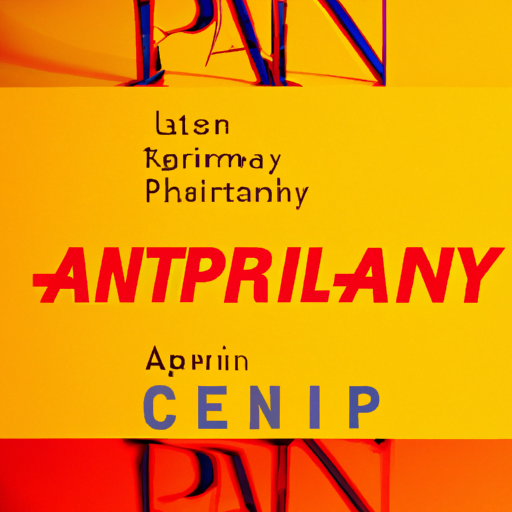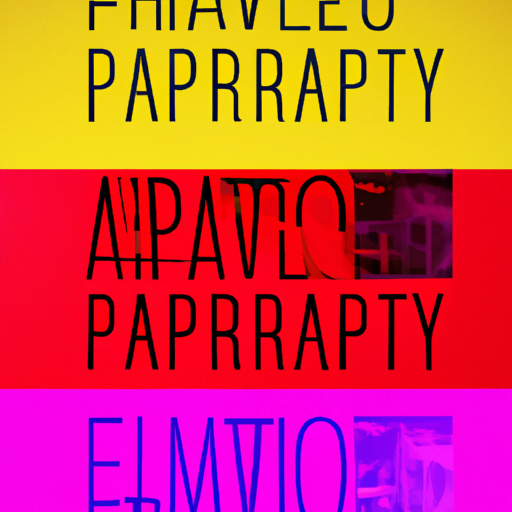
-
Table of Contents
- Experimental Typography: Pushing the Boundaries of Design
- The Origins of Experimental Typography
- Techniques and Approaches in Experimental Typography
- Case Studies: Examples of Experimental Typography
- 1. “The Crystal Goblet” by Beatrice Warde
- 2. “The Beauty of Letterpress” by Neenah Paper
- 3. “Typography in Motion” by AIGA
- The Impact of Experimental Typography
- Summary
Experimental Typography: Pushing the Boundaries of Design

Typography is an essential element of design that has the power to evoke emotions, convey messages, and create a unique visual experience. While traditional typography has its place in design, experimental typography pushes the boundaries, challenging conventions and exploring new possibilities. In this article, we will delve into the world of experimental typography, exploring its origins, techniques, and the impact it has on the design industry.
The Origins of Experimental Typography
Experimental typography emerged as a response to the limitations of traditional typography. Designers sought to break free from the constraints of conventional typefaces and explore new ways of expressing ideas through typography. The movement gained momentum in the early 20th century, with artists and designers like El Lissitzky, Kurt Schwitters, and Jan Tschichold experimenting with unconventional layouts, letterforms, and compositions.
One of the most influential figures in experimental typography was Jan Tschichold. In his groundbreaking book “Die neue Typographie” (The New Typography), published in 1928, Tschichold advocated for a more functional and systematic approach to typography. He emphasized the use of asymmetrical layouts, sans-serif typefaces, and the integration of photography and graphic elements.
Techniques and Approaches in Experimental Typography
Experimental typography encompasses a wide range of techniques and approaches that challenge the traditional rules of typography. Here are some of the key techniques used by designers in this field:
- Deconstruction: Deconstructing letterforms and rearranging them in unconventional ways is a common technique in experimental typography. This approach allows designers to create unique and visually striking compositions that challenge the reader’s perception.
- Layering: Layering different typefaces, textures, and colors can add depth and complexity to typographic designs. By combining various elements, designers can create visually rich and dynamic compositions.
- Motion Typography: Motion typography involves animating letterforms to create dynamic and engaging visual experiences. This technique is often used in video production, advertising, and digital media.
- Experimental Typefaces: Designers are constantly pushing the boundaries of type design by creating experimental typefaces. These typefaces often feature unconventional letterforms, exaggerated proportions, and unique stylistic elements.
- Typography in Three Dimensions: Experimental typography is not limited to two-dimensional designs. Designers are exploring the use of three-dimensional typography, incorporating depth, perspective, and physical materials to create immersive typographic experiences.
Case Studies: Examples of Experimental Typography
Let’s explore some real-world examples of experimental typography to gain a better understanding of its impact and potential:
1. “The Crystal Goblet” by Beatrice Warde
In her influential essay “The Crystal Goblet,” Beatrice Warde challenges the notion that typography should be invisible and transparent. She argues that typography should be seen as a vessel that carries and enhances the content, rather than being a mere vehicle for communication. This essay is a prime example of how experimental typography can provoke thought and challenge established norms.
2. “The Beauty of Letterpress” by Neenah Paper
Neenah Paper, a leading paper manufacturer, created a promotional campaign called “The Beauty of Letterpress” to showcase the versatility and beauty of letterpress printing. The campaign featured a series of posters that combined traditional letterpress techniques with experimental typography. The result was a visually stunning collection of designs that pushed the boundaries of what is possible with letterpress printing.
3. “Typography in Motion” by AIGA
The American Institute of Graphic Arts (AIGA) organized an exhibition called “Typography in Motion” to explore the intersection of typography and motion design. The exhibition featured a collection of animated typographic works that demonstrated the creative potential of combining typography and motion. This case study highlights the growing importance of motion typography in the digital age.
The Impact of Experimental Typography
Experimental typography has had a profound impact on the design industry, pushing the boundaries of what is considered possible and acceptable in typography. Here are some key ways in which experimental typography has influenced the field:
- Inspiration and Innovation: Experimental typography inspires designers to think outside the box and explore new possibilities. By challenging conventions, designers can push the boundaries of design and create innovative solutions.
- Emotional Impact: Experimental typography has the power to evoke emotions and create a unique visual experience. By breaking free from traditional constraints, designers can create designs that resonate with the audience on a deeper level.
- Branding and Identity: Experimental typography can help brands stand out and create a distinct identity. By using unconventional typefaces and layouts, brands can differentiate themselves from competitors and leave a lasting impression on their audience.
- Accessibility and Inclusivity: Experimental typography has also played a role in improving accessibility and inclusivity in design. By exploring new ways of presenting information, designers can create designs that are more accessible to people with visual impairments or reading difficulties.
Summary
Experimental typography is a fascinating field that pushes the boundaries of design, challenging conventions and exploring new possibilities. From deconstructing letterforms to animating typography in motion, designers are constantly pushing the limits of what is possible with typography. Through case studies and examples, we have seen how experimental typography can provoke thought, inspire innovation, and create unique visual experiences. As the design industry continues to evolve, experimental typography will undoubtedly play a crucial role in shaping the future of design.
